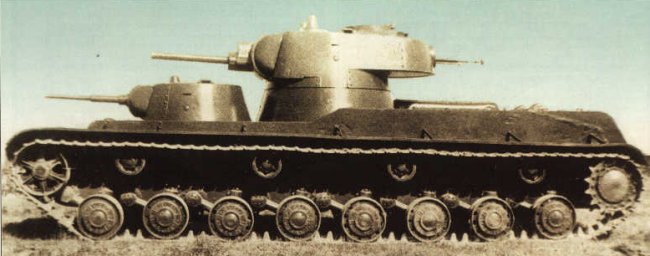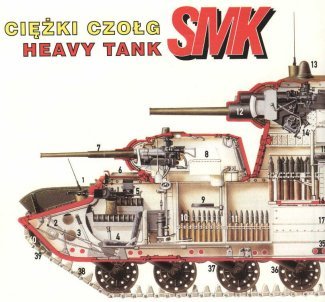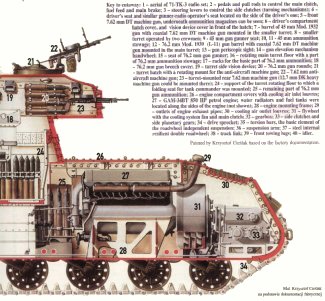
In the mid 1930's the multi-turreted T-35 heavy tank entered service with the RKKA (Red Army). It was developed in the Design Bureau (later Zavod #185) of the Leningrad's "Bolshevik" plant in 1932. In 1933, all blueprints was transferred to the Kharkov Locomotive Works (ChPZ) named after Komintern and the improved T-35A was manufactured here.The T-35 was to be manufactured until an even more powerful super-heavy tank was developed. A super-heavy T-39 tank was designed in 1932-34, but none of them was approved. In July 1932, a government decision was taken that recommended the designers at ChPZ to design a new variant of a T-35 with improved (uparmored, upgunned) hull and turrets. Because of a delay at ChPZ, designers from Leningrad's Kirow Plant (LKZ) and Zavod #185 were called in to design own variants. A team at Zavod #185 led by N. Barykov designed a T-100 (Izdieliyc 100). The Leningrad's Locomotive Works (LKZ) team was led by Colonel Z. Kotin , and it developed the SMK heavy tank. It was a three-turret tank with a 76.2mm gun fitted in the main turret and two 45mm guns in the smaller turrets. Maximum armor protection was 60mm and it was to protect the machine from 76mm gun projectiles. Several T-35 components were used, and completion of the first prototype was scheduled for May 1st 1939. A 1:1 scale wooden mock-up of the SMK was presented to a special commision on October 11th 1938, and on December 9th 1938, the first finished prototype was demonstrated at the Kremlin. Stalin reportedly personally removed one of the smaller turrets and recommended an increase in armor thickness. Since January 1939 construction of the first double-turreted SMK prototype began. On 30th April 1939, a nearly finished prototype rolled out from the assembly building for the first time. The prototype was sent to Kubinka Proving Grounds on 25th of July, and trials began in the night of July 31st and 1st of August. On the 20th of September that SMK prototype was presented to representatives of the Communist Party, Defence Commisariat and other industry agents.

In December 1939 it was decided to send the SMK to continue its trials under real combat conditions. The crew partially consisted of LKZ workers and partially of army tankists, the SMK under command of Senior Lieutenant N. Pietin was sent by rail to Karelian Pass. Here, the SMK linked up with experimental tanks T-100 and KW, and joined the special super heavy tank company under command of Captain I.L Lolotushkin of the 91st Tank Battalion in the 20th Armored Brigade. The tank saw combat for the first time on December 17th 1939 in the area of Hottinen. On 19th of December it took part in an attack on Finnish fortifications near Summa and was immobilized and the crew was evacuated by the T-100 heavy tank.

The abandoned SMK tank, Summa, December 1939.
The SMK remained in this position for more than
two and a half months. The Finns made several attempts to tow away this unknown tank,
however they didn't possess any equipment powerful enough for its purpose and in addition
Soviet artillery was shelling the area heavily to prevent access to the abandoned SMK.
Many stories about the Finnish attempts to examine the SMK in detail were later reported
in the USSR (for example that on a mysterious disappearance of the driver's hatch), but no
stories have been found in Finland. German intelligence quickly found out the appearance
of this new "100 ton tank", but it was pretty overlooked. In German tank
recognition directorates the SMK tank were named
PzKpfw. Mark T-35C 752(r). In February 1940 Soviets gained access to the SMK, and on
February 26th the SMK was inspected by a representative of the ABTU (Armored Forces
Directorate) who found a damaged bottom and a lack of external equipment. In March 1940,
six (!) T-28 tanks connected to eachother could tow the SMK to the Perkij�rvi rail
station. The SMK were here stripped and were sent back to LKZ by rail. After this, ideas
were abandoned to construct super-heavy tanks, and such was the end of one of the
"Leningrad-monsters".


SMK Interior
(illustration made by Krzysztof Cieslak, published in Pelta's "Armor in Profiles
#1")
1. Aerial of 71-TK-3 radio set
2. Pedals and pull rods to control the main clutch, fuel feed
and main brake
3. Steering levers to control the side clutches (turning mechanisms)
4. Driver's seat and similar gunner-radio operator's seat located on the side of the
driver's one
5. Front 7.62mm DT machinegun, underneath ammunition magazines can be seen
6. Driver's compartment hatch cover, and vision device cover in front of the hatch
7. Barrel of 45mm Model 1932 gun with coaxial 7.62mm DT machinegun mounted in the smaller
turret
8. Smaller turret operated by two crewmen
9. 45mm gunner's seat
10, 11. 45mm ammo stowage
12. 76.2mm L-11 Model 1939 gun barrel with coaxial 7.62mm DT machinegun mounted in the
main turret
13. Gun periscope sight
14. Gun elevation machanism handwheel
15. 76.2mm gunner's seat
16. Rotating main turret floor with a part of 76.2mm ammo stowage
17. Racks for basic part of 76.2mm gun rounds
18. 76.2mm gun breech cover
19. Turret side vision device
20. 76.2mm gun rounds
21. Turret hatch with a rotating mount for the anti-aircraft machinegun
22. 7.62mm antiaircraft machinegun
23. Turret-mounted rear 7.62mm machinegun
24. Support of the turret rotating floor to which a folding seat for tank commander was
mounted
25. Remaining part of 76.2mm gun ammunition
26. Engine compartment covers with cooling air inlet louvres
27. GAM-34BT 850hp petrol engine, water radioators and fuel tanks were located alng the
side of the engine (not shown)
28. Engine mounting frame
29. Outlets of engine exhaust pipes
30. Cooling air outlet louvres
31. Flywheel with the cooling system fan and main clutch
32. Gearbox
33. Side clutches and side planetary gears
34. Drive sprocket
35. Torsion bars, the basic element of the roadwheel independent suspension
36. Suspension arm
37. Steel internal resilient double roadwheel
38. Track link
39. Front towing lugs
40. Idler